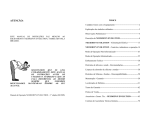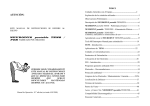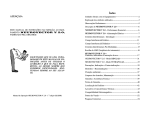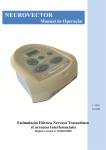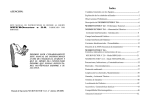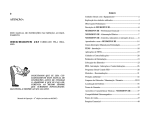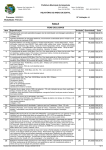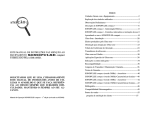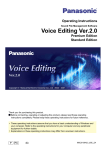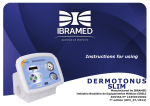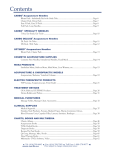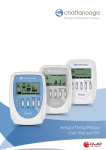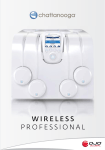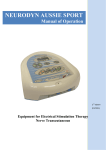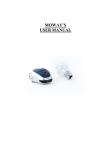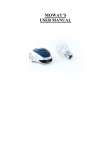Download Manual - Ibramed
Transcript
ATTENTION: TABLE OF CONTENTS General care of the equipment----------------------------------------------2 Explanation of the utilized symbols---------------------------------------3 Preliminary Observations---------------------------------------------------5 THIS MANUAL OF INSTRUCTIONS REFERS TO NEUROVECTOR V 2.0 EQUIPMENT MANUFACTURED BY IBRAMED NEUROVECTOR V 2.0 Description--------==-------------------------6 NEUROVECTOR V 2.0 – Essential Performance---------------------6 NEUROVECTOR V 2.0 – Electrical AC Input------------------------7 Interferential Currents - Introduction--------------------------------------8 Static Interferential Field--------------------------------------------------11 Dynamic Interferential Field----------------------------------------------13 Pre-modulated Interferential Currents-----------------------------------15 AMF Selection (treatment frequency)-----------------------------------16 PLEASE READ THIS MANUAL CAREFULLY BEFORE USING THE EQUIPMENT AND ALWAYS REFER TO IT WHENEVER DIFFICULTIES APPEAR. KEEP THIS MANUAL ALWAYS AT HAND. NEUROVECTOR V 2.0 – Controls, indicators and usage instructions-----------------------------17 NEUROVECTOR V 2.0 – BIPOLAR Mode---------------------------31 NEUROVECTOR V 2.0 – TETRAPOLAR Mode--------------------33 Cautions, Indications and Counter-indications-------------------------35 Electrodes – Recommendations------------------------------------------36 Environmental Protection--------------------------------------------------37 Cleaning of the Electrodes / Maintenance-------------------------------38 Warranty and Technical Assistance--------------------------------------21 Sales Points------------------------------------------------------------------40 NEUROVECTOR V 2.0 Operation Manual – 2st edition (09/2009) Warranty Term--------------------------------------------------------------41 Trouble spotting-------------------------------------------------------------43 Accessories and Technical Characteristics------------------------------44 Electromagnetic Compatibility-------------------------------------------47 Free Technical Assistance Contract--------------------------------------53 the input plug from socket when not using the equipment for a long period of time. 1 2 General Care of the Equipment ATTENTION RISK OF ELECTRIC SHOCK DO NOT OPEN The NEUROVECTOR V 2.0 does not need special installation measures or care. We suggest that you: ♦ Avoid places subject to vibrations. The lightning bolt symbol inside a triangle is a warning about the presence of “dangerous voltage”, without insulation in the internal part of the equipment which may be strong enough to cause risk of electrical shock. ♦ Install the equipment on a firm and horizontal surface, in a site with perfect ventilation. ♦ In case of a built-in cabinet, verify that there is no block for free circulation of air in the rear part of the instrument. ♦ Do not lay it on carpets, rugs, cushions or other soft surfaces that can obstruct the ventilation. ♦ Avoid humid, hot and dusty places. An exclamation mark inside a triangle alerts the user about the existence of important operation and maintenance instructions (technical service) for this equipment. ♦ Place the cable in order to leave it free, out of places where it can be trodden on, and do not place any furniture over it. ♦ Do not insert objects into equipment orifices and do not place recipients with liquid on it. ATTENTION: To prevent electrical shock do not use the equipment plug attached to an extension cable or to any other type of plug except that the terminals fit perfectly in the receptacle. Disconnect ♦ Do not use volatile substances (benzene, alcohol, thinner and solvents in general) to wipe the equipment cabinet because they can damage the finishing. Use only a soft, dry, and clean piece of cloth. 4 Explanation of the Symbols Used - - Indicates: On (with electrical power supply) 3 ATTENTION! Check and follow the instructions in this manual. V~ ~ line - Equipment CLASS II. The protection against electric shock is not based only in the basic insulation but also incorporates additional safety precautions, such as double or reinforced insulation, not holding grounding resources protection or depending on installation conditions. - - Alternate current power line In the Transportation Box: -FRAGILE: The content in this package is fragile and should be handled with care. Equipment with BF type applied part. - - Volts in Alternate Current - THIS SIDE UP: Indicates the correct position to ship the package. Risk of electrical shock. IPX0 - Equipment not protected against harmful water dripping. 50ºC - Indicates electrostatic discharge sensibility 5ºC - TEMPERATURE LIMITS: Indicates the limit temperatures for transportation and storage the package. - Indicates the start of the action (START) - Indicates the end of the action (STOP) - Indicates: Off (without electrical power supply) KEEP IT AWAY FROM THE RAIN: This package should not be shipped under rain. 6 5 5 - MAXIMUM STACKING NUMBER: The maximum number of identical packages which can be stacked. For this equipment, the limit stacking number is 5 units. Preliminary Observations The NEUROVECTOR V 2.0 is an electrical stimulator use in therapies for interferential medium frequency currents. This technique is noninvasive, without systemic effects, it does not cause dependency and it does not have undesirable side effects. As for the type and degree of protection against electrical shock, the NEUROVECTOR V 2.0 corresponds to a BF – applied part CLASS II of safety and protection. It must only be operated by qualified professionals and in duly accredited medical departments The use of these units is not intended for rooms with risk of explosion such as anesthesia departments or the presence of an anesthetic flammable mixture with air; oxygen or nitric oxide. POTENTIAL ELETROMAGNETIC INTERFERENCE: As for the limits regarding electromagnetic disturbance, Neurovector V 2.0 ist electro-medical equipment that belongs to Group 1, Class A. The simultaneous connection of the patient to the NEUROVECTOR V 2.0 stimulator and to surgical equipment of high frequency can cause burns in the application area of the electrodes and it may damage the stimulator. The operation at a short distance (1 meter for example) from shortwave or microwave therapy equipment can produce instability in the output of the equipment. In order to prevent electromagnetic interference; we suggest you to use an electric network line for NEUROVECTOR V 2.0 and a separate group for short wave or microwave equipment. We also suggest that the patient, o NEUROVECTOR V 2.0 and the connection cables are placed at least at a distance of 3 meters away from the shortwave or microwave therapy equipment Mobile or portable radio frequency communication equipment may produce interference and affect the performance of Neurovector V 2.0. IBRAMED Description of the NEUROVECTOR The NEUROVECTOR V2.0 was designed following the existing technical manufacturing standards for medical equipment (NBR IEC 60601-1 NBR IEC 60601-1-2 and NBR IEC 60601-2-10). Basic Performance: The Neurovector V2.0 is equipment for electrical current application through electrodes in direct contact with the patient for neuromuscular dysfunction therapy. It is a transcutaneous muscular stimulator with microcomputer technology, this means, it is microcontrolled. This equipment is intended for therapies with interferential currents and medium frequency alternate currents. This technique is noninvasive, without systemic effects, it does not cause dependency and it does not have undesirable side effects. The current intensity necessary for the treatment depends on the sensation of the patient. Thus, the treatment must start with minimum intensity levels (very low), carefully increased until obtaining the adequate effects of the procedure and according to the reaction of the patient. The importance of medium frequency alternate currents is indisputable in electrotherapy. In the Neurovector V 2.0, these alternate currents have an operation frequency of 2000 Hz, 4000 Hz or 8000 Hz, that penetrate deeply in the tissues, producing a great variety of physiological effects. They allow for high current densities with a slight sensorial effect on the skin, becoming quite pleasant to the patient. The danger of burns under the electrodes is minimal. The so called interferential current is a technique in which two medium frequency alternate currents, of different phases or frequencies cross. The superposition of the amplitudes results in a new frequency called “Bouncing Frequency” or “Modulated Amplitude Frequency” (AMF). We highlight the following characteristics of the NEUROVECTOR V 2.0: • Operation via touch keyboard with the information demonstrated on an alphanumerical liquid crystal display. • Interferential stimulation mode: Bipolar (pre-modulated)- continuous or surge mode; Tetrapolar- normal or with manual or automatic vector exploration. 7 • • • • Possibility of selecting the automatic sweeping range of the Modulated Amplitude Frequency - SWEEP (also known as ∆ AMF). Possibility of selecting the carrying frequency at 2000 Hz, 4000 Hz or 8000 Hz. On, Off, Rise and Decay for muscle exercise (surge mode). Possibility of selecting the application time, automatically disconnecting the emission current at the end of the program. NEUROVECTOR V 2.0 ELECTRICAL INPUT NEUROVECTOR V 2.0 is a CLASS II monophasic equipment with BF applied part of safety and protection. Functioning in network voltages in the range of 100 – 240 volts 50/60 Hz consequently, it is not necessary to be concerned regarding the voltage of the local power supply line. Just plug in the equipment to the “power outlet” and the equipment will perform, automatically, the selection to 110/220 volts. The connection cable to the electric line is detachable. The equipment uses the line plug as a resource to separate electrically the circuits of the power line in all the poles. ATTENTION: On the rear part of the Neurovector V 2.0, is located the protection fuses. To replace them, turn the equipment off, unplug it from the power outlet and, with a small screwdriver, take the protective lid off, disconnect the fuse, perform the replacement and put the lid back to its original place. Install the correct fuses: Use a fuse for 5.0A nominal current, 250V~ operation voltage and rapid action 20AG model (50A rupture current). SECURITY RISKS MIGHT OCCUR IF THE EQUIPMENT IS NOT PROPERLY INSTALLED. NOTE: There are dangerous voltages inside them. Never open the equipment. 8 INTERFERENTIAL CURRENTS - Introduction Resistance of the Skin: As it is already known, our biological systems respond to low frequencies, this means, within an approximate range of 0.1Hz to 200Hz. This is called the biological reach range. Therefore, the current stimulators work within this range. However, the human skin offers high resistance to the passage of these low frequency currents and with a relatively long duration of the pulse. Since the resistance of the skin is high, a higher voltage shall be applied to the skin to get the correct and necessary current into the tissues. The higher the applied voltage, the higher will be the current intensity and the stimulus may become unpleasant to the patient. If the resistance of the skin is lowered, a lower voltage will be necessary. However, the skin is a complex biological resistance; it is hard to predict the exact value of the resistance in any part of the body. The skin acts as a linear resistance and also as a condenser. The resistance offered by a condenser to the passage of alternate current is called capacitive reactance. It acts in combination with the linear resistance of the skin. The capacitive reactance has a useful feature, this means, it decreases as the frequency of the applied current increases. Consequently, if we had a current of higher frequency, the resistance of the skin will decrease, providing a more efficient stimulation. Additionally, higher frequencies have a shorter pulse duration, leading to a more pleasant stimulus. In electrotherapy, the “spectrum" of the frequency can be divided thus: High Frequency : > 100,000 Hz (100KHz) Medium Frequency : 1,000 to 100,000 Hz (1KHz to 100KHz) Low Frequency : > 1,000 Hz (1KHz) 9 If we increase this frequency, this resistance of the skin will dramatically drop. Research shows that the resistance of the skin is very low when the applied alternate current is in the range of 2,000 Hz to 10,000 Hz. These alternate currents of Medium Frequency of operation of (2,000 Hz to 10,000 Hz) penetrate deeply into the tissues, producing a great variety of physiological effects. Since in this case the resistance of the skin is low, high current densities with low sensorial effect on the skin are possible, becoming quite pleasant for the patient. The danger of burns under the electrodes is minimal. However, we have a problem. As it has been seen, in order to lower the resistance of the skin, we use Medium Frequency current in the range of 2,000Hz to 10,000 Hz. However, it is not known that the “biological range”presented by the tissues is from 0.1 Hz to 200 Hz (Low Frequency) ? The Medium Frequency currents are very far from the biological range of the tissues! And now? 10 of the two currents generated in each channel. In interferential therapy, AMF (treatment frequency) corresponds to the frequencies normally used in electrotherapy with low frequency. Consequently, we have the advantages of medium frequencies (4,000 Hz – resistance of the lower skin) and are well within the biological range 0.1 to 200 Hz (AMF). AMF = f2 - f1 f2 = 4,050 Hz and f1 = 4,000 Hz AMF = 4,050 – 4,000 = 50 Hz (treatment frequency) C A 1 B A Stimulation by INTERFERENTIAL CURRENTS: 2 B “Interferential Current” is the phenomenon that occurs when two or more oscillations are applied simultaneously at the same point. In interferential therapy, two medium frequency alternate current stimuli (4.000 Hz to 4.100 Hz for example), are applied at the same time on the same point. One of these alternate current stimuli is fixed at 4,000 Hz while the other stimulus can be selected from 4,001 Hz to 4,100 Hz. A third frequency called “Bouncing Frequency” or “Modulated Amplitude Frequency (AMF)” is created where these two medium frequency stimuli cross. For example: The interferential current equipment has two output channels. Channel 1 is fixed at 4,000 Hz and channel 2 is variable from 4,001 Hz to 4,100 Hz, this means, this channel 2 frequency is selected by the operator within this range from 4,001 Hz to 4,100 Hz. Then supposing that the frequency selected on channel 2 is 4,050 Hz and the frequency on channel 1 is fixed at 4,000 Hz, a third frequency (AMF) of 50 Hz will be generated on the intersection points C A C B 1 ciclo da frequência de batimento Figure 1 – In the above diagram, 1 is the channel fixed at 4,000 Hz and 2 is the channel where the frequency was selected at 4,050 Hz. At certain points, the two phases will be identical (A and B) and in such situations, the resulting sum will produce an increase in the total amplitude. In point (C), the two currents are equal and opposite, canceling each other. The “envelope” (dotted line) shows the shape of the bouncing frequency cycle. The number of envelopes per second represents the AMF, this means, 4,050 Hz – 4,000 Hz = 50 Hz (treatment frequency). 11 12 STATIC INTERFERENTIAL FIELD (normal or standard tetrapolar) In interferential treatment known as normal or standard tetrapolar, four electrode are necessary (two per channel). These four electrodes are usually applied on the patient as shown in figure 2. Circuit 2 Circuit 1 Circuit 1 Direction Of the interferenti al effect Circuit 2 Figure 2 The two circuits are placed in the best possible diagonal manner. The interferential effect occurs only in the shaded areas. Meanwhile, the shaded areas in the figure are applied only for homogenous tissue. In the majority of clinical situations, the tissues of the patient are not homogenous and the area represented in the figure will probably be modified. The field seen in figure 2 is known as the Static Interferential Field. At this point, it is important to make some considerations regarding the application of the electrodes in interferential therapy. An effective treatment only occurs when the patient perceives a dominant sensation concentrated in the area where the problem is found. In other words, the patient will feel a significant pricking sensation around and in the area where the problem is found. An adjustment in the position of the electrodes on the skin is important to achieve the best results. One of the reasons found for the results not to be satisfactory in interferential therapy is the inadequate position of the electrodes. The patient should experience a pleasant prickling sensation (as “soft as a needle prick”). It is possible for the patient to experience a sensation under the electrode; but must also always feel the possible “prickling” sensation in the are where the problem is located. The “leaf shaped” model shown in figure 2 represented the so called Static Interferential Field and is commonly used to describe the area of interferential effect. However, there are other aspects in the shape and distribution of this field. Since there is no practical way to measure the interferential effect area, the professional must rely on the report of the patient regarding the area and stimulation extent. It is relatively easy to find the effect when the four electrodes are close to each other; but this serves as a superficial comparison of the treatment. There are mathematical methods to describe the effect of interference and its distribution, but their use is clinically limited because of certain situations encountered by the patient. 13 DYNAMIC INTERFERENTIAL FIELD (tetrapolar with manual or automatic vector) The described Static Interferential Field represents the tetrapolar—normal or standard mode or application standards of interferential currents. Over the years, this basic process underwent interesting developments. The most significant was the so-called “Manual Vector” and “Automatic Vector”. This Manual or Automatic Vector mode is nothing more than the flow of current produced increases the two circuits (channels) together in a vectorial manner. A better technical description would be the concept of de “rotational” or “dynamic” vector system. The concept of “dynamic” vector system is basically simple, this means, it involves the rotation of the Static Interferential Field of zero to approximately 45 degrees and back to zero again. The field influence area in the tissue becomes more extensive than in the Static Interferential Field. This “movement” is rhythmically produced by the design of the currents, altering the position of the maximum stimulation area. Figure 3 illustrates this principle. 14 In the case where the patient presents not well localized symptoms, the dynamic vector system (automatic vector) can be a useful method for this problem. However, it should be understood that, since the field of influence is “sweeping” the tissues, a part pf the treatment time can not be spent on the injury. The “automatic vector” (dynamic vector) system should not be seen as a shortcut to allow for the therapeutic treatment of the problem without locating it correctly. With the electrodes well placed before the start of the treatment, the dynamic vector systems may increase the efficiency of the treatment. However, this treatment efficiency depends largely on the correct placement of the electrodes. It is worth emphasizing here, that the effects seen in figure 3 occur in homogenous medium. It is difficult and almost impossible to accurately predict the pattern of the interferential effect on the patient subject to the static or dynamic interferential fields. There is no evidence to suggest that the manual or automatic vector” mode is significantly better than the "normal or standard" mode. EQUILIBRIUM OF THE CIRCUITS (“BALANCE OF THE CHANNELS") Circuit 2 100% Of Interferential effect Circuit 1 1 45º 2 Figure 3 These arrows Indicate the placement of the interferenti field The “Balance of the Channels” is used in normal Tetrapolar Interferential mode (static interferential field). To achieve a maximum therapeutic effect, it is necessary to ensure that the current flowing between the two channels are equal. Since the body tissues are not homogenous, it is necessary to adjust the current of the channels so that they are equilibrated (“balanced”). Some equipment perform this “balance” automatically, for others, it must be adjusted externally by the therapist through a control called balance or adjusting the same current in the two channels. The Neurovector V 2.0 uses constant output current technology for the patient. Therefore the balance is achieved by placing the same current (mA) in the two channels. Remember that the level of current to be applied can be different for each patient. Consequently, the intensity should be “felt”, however it should be pleasant to the patient. Even in normal Tetrapolar mode, the Neurovector V 2.0 allows the performance of manual operation (MANUAL VECTOR), where the therapists manually rotates the interferential field “trying to localize”, according to what is reported by the patient, the exact location of the problem. 16 15 For this, simply unbalance the channels, this means, leaving a channel with lower or higher current than the other. For example: Suppose that there is a current intensity of 30 mA in channel 1 and 30 mA in channel 2 (equilibrated circuit, balanced). If you decrease and increase only channel 2, you will be “rotating” the vector. In the Neurovector V 2.0, you can also select the automatic vector stimulation mode, where the equipment will complete the “rotation of the vector” automatically. Remember that the “manual vector” or “automatic vector” techniques are valid only in normal Tetrapolar Interferential mode. PRE-MODULATION INTERFERENTIAL CURRENTS (bipolar) It is possible to emit interferential currents to the patient using two electrodes instead of the conventional four. In this system, the two currents are combined inside the equipment and transmitted to the patient through two electrodes. There is a significant different between this technique and tetrapolar-normal mode which uses four electrodes. In conventional mode (tetrapolar-normal), the interferential current is produced endogenously (inside, deeply) in the patient. In bipolar mode (pre-modulated) the interferential current is applied through two electrodes to the skin of the patient. It is unlikely that there is a clinical difference between the two methods other than the obvious ease of application in pre-modulation mode. For many situations, the pre-modulated mode is mostly selected, for example: in muscle stimulation. The equipment that have the Bipolar mode (pre-modulated), normally require the use of only two channels. The terms “two poles” or “bipolar” can be misleading, because this can imply two different poles. As in interferential therapy, alternate currents are used (without a fixed polarity), the term "pre-modulated" or "precombined" more clearly describes the application technique. AMF CONTROL – Treatment frequency (bouncing frequency) AMF, also known as bouncing frequency or treatment frequency, can be controlled by two basic methods known as In “Continuous” (constant) and “Sweep” ( ∆ AMF) mode. Continuous (constant) mode, the equipment generates a unique bouncing frequency that can be selected by the operator. In this method, the equipment generates a constant difference in the frequency between the two channels. For example: as already mentioned, the frequency in one channel is always 4,000 Hz and the frequency in the other channel varies from 4,001 Hz to 4,100 Hz. In Continuous (constant) mode, the operator selects a frequency of 4,050 Hz, the equipment generates a different between the two channels (4,050 – 4,000), this means a fixed treatment frequency – AMF (bouncing frequency) of 50 Hz. A more useful method for controlling the bouncing frequency is “Sweep” ( ∆ AMF) mode. In this case, the equipment automatically generates the bouncing frequency inside a pre-selected range. This pre-selected range is known as “frequency extension”. The word extension can be interpreted as range of treatment frequency. This frequency range is automatically and rhythmically increased and decreased inside a pre-established AMF range. For example: An AMF (basic treatment frequency) of 20 Hz is selected and an extension, this means, Sweep ( ∆ AMF) of 50 Hz is required. The current released to the patient starts with an AMF (treatment frequency) of 20 Hz and (with an extension of 50 Hz) passing successively through the other frequencies until a frequency of 70 Hz is reached, then gradually decreasing until 20 Hz. This process is repeated automatically. The “SWEEP” mode is widely used for avoiding adaptation. A “large” extension will prevent adaptation more efficiently than a "close" extension. Using a large extension of frequency, notable sensations and/or contractions occur. Selection of AMF or Treatment Frequency: The selection of AMF depends on the nature, stage, severity and location of the problem. The sensations experienced by patients in different AMF should be considered. Higher frequencies are perceived as “pleasant and lighter”. Higher AMF (75 Hz to 200 Hz) are recommended for acute, high pain or hypersensitivity problems. When the patient demonstrates a certain fear to electrostimulation, a high AMF should be used at the start of the treatment. In low frequencies the sensation is more “rough and heavy”. Frequencies between 25 Hz to 50 Hz tend to produce contractions (tetanic). In muscle contractions, chronic or sub-acute problems, a low AMF is more appropriate. Low frequencies of 50 Hz produce pulsed and fibrillated contractions. 17 NEUROVECTOR V 2.0 – Controls, indicators, and operation 18 19 20 How to use the Neurovector V 2.0: 1- ON/OFF switch. 2- Luminous indicator of the “connected” condition. 3- BACK/NEXT keys. 4- SET+ and SET- control keys. As described previously, all the parameters are programmed by touch screen and indicated in the displayed crystal screen. Thus, the necessary steps to operate the equipment are listed as follows. Liquid crystal screen: 5- Alphanumerical liquid crystal DISPLAY 6- STAR/STOP keys 7- PROGRAM control key. 8- UP and DOWN control keys – channel 1 intensity. 9- UP and DOWN control keys – channel 2 intensity. 10- luminous (yellow) indicators of channel 1 and 2 of the presence of an output current intensity for the patient that may present a resistance to a charge of 1000 ohms, a tension higher than 10 V or a current higher than 10 mA. In SURGE bipolar interferential mode, this indicator "will flicker" in accordance with the On Time, OFF Time, Rise and Decay times 11- Connection of output cables to the patient – CHANNEL 1 and CHANNEL 2. 12- Power cable port to be connected to the power supply line. Field designed for the selection of the mode of interference: Tetrapolar (TP) or Bipolar (BP). Field intended for the selection of the carrying frequency at 2000 Hz, 4000 Hz or 8000 Hz. Field intended for the selected of the vacuum operation mode: 13- Fuse rack. 14- General characteristics board. 15- Tag with the characteristics of the output current of the NEUROVECTOR V 2.0. Field intended for the selection of the SWEEP (▲AMF) frequency range from 1 to 100Hz. Field intended for the selection of the modulation frequency (bouncing frequency): 1 to 100Hz. Field designed for the selection of the mode of stimulation: normal Tetrapolar; Tetrapolar with automatic vector; continuous Bipolar and surge Bipolar. 21 22 When in Surge Bipolar mode - field designed for the selection of the parameter PULSE RISE TIME (time to go from rest to maximum contraction – pulse increase gradient), variable from 1 to 9 seconds. Note that the MODE – TP (TETRAPOLAR field is flickering. When in Surge Bipolar mode - Field designed for the selection of the parameter CONNECTION TIME (time of sustentation of the maximum muscle contraction), variable from 1 to 60 seconds. 2 o Step: BACK and NEXT (3) control keys: These keys are used to select the necessary treatment parameters. As you press the NEXT key, you will be advancing to another parameter. As you press the BACK key, you will be returning to the previous parameter. Note that at each selection you choose through the BACK and NEXT keys, the chosen parameter will be in flashing mode. When in Surge Bipolar mode - field designed for the selection of the parameter PULSE DESCENT TIME (time to go from maximum contraction to rest – pulse decrease gradient), variable from 1 to 9 seconds. 3 o Step: SET + and SET - (4) control keys: These keys are used to choose the marks of each necessary parameter to the therapy. When in Surge Bipolar mode - field designed for the selection of the parameter REST TIME (time of the muscle contraction), variable from 1 to 60 seconds. Field designed for the selection of the parameter APPLICATION TIME (TIMER). Allows for the selection of an application time of 1 to 60 minutes. 1 o Step: Turn on – turn off key (1). When turning on the equipment, the liquid crystal display (5) will show, for a few seconds, the following presentation message: MODE SWEEP MODE CARRIER SWEEPFREQ. ( Hz ) SWEEP MODE AMF( Hz) IBRAMED STIM. MODE RISE ON DECAY SWEEP FREQ. ( Hz ) NEUROVECTOR v 2.0 OFF After this presentation, a sound signal (“beep”) will be heard and the screen (5) will start operating, now indicating: SWEEP MODE SWEEP FREQ. ( Hz ) SET+ Increasing values. SET- Decreasing values. 4 o Step: START / STOP (6) control keys - Once the parameters and their values are respectively selected (as described in the previous paragraphs), press the START key. Observe that the parameters stop to flicker. At this moment the program will start. Now choose the current intensity necessary for the treatment. If you wish to interrupt the application, just press the STOP key. The current will be interrupted and the parameters will flicker again in order to perform a new programming. At the end of the programmed time you will hear a sound signal (several "beeps") and the current will stop. Press the STOP key so that the sound signal is disconnected and for the equipment to go back to the programming condition. As you can see, there are two functions in the same keyboard. START – beginning the treatment. STOP – stop the treatment. 23 24 NOTE: 1- If during the programming you forget to enter the application time, a sound signal (“beeps”) will also be emitted, indicating an operation error. At this moment the screen (5) will display: SWEEP MODE SWEEP FREQ. ( Hz ) Press the STOP (6) key and note that the error message has disappeared. Then, select the necessary time and continue your work. 2- Once the “Start” is pressed for the treatment, the BACK and NEXT (3), SET+ and SET- (4) keys do not operate any more, new values for the parameters during the application cannot be selected and chosen. In this case, the "Stop” key must be pressed in the treatment and then, modify the parameter. 3 – If the operator wants to interrupt the treatment or choose a new time after the end of application alarm sounds, they will need to press the STOP (6) key again for the equipment to go back to the condition of programming new parameters. Thus, the equipment is ready to receive a new programming. 4- When the type of stimulation selected (STIM. MODE) is SURGE, the luminous indicators of channels 1 and 2 “flicker” according to the Rise, On, Decay and Off times selected (onindicators turned on, off-indicators completely turned off). We suggest increasing the intensity of the channels only when the LEDs are turned on (maximum contraction). The SURGE mode operates only when the interferential mode of Bipolar (BP) is selected. 5- In case the electrical network stops (“lack of electricity”), the equipment will be disconnected automatically. Thus, when the network energy comes back, you must execute again the programming necessary for the treatment. As it has been seen up to this point, the Neurovector V 2.0 panel is self-explanatory, only a few minutes of use is enough to become familiarized with its programming. NOTE: We suggest that the preparation procedures for the patient and the placing of the electrodes are performed before connecting and programming the instrument. Example 1: Let us suppose that the clinical practice or existing literature suggests the BP (Bipolar) interferential mode with Surge stimulation mode, with the following parameters for a certain pathology: - Carrying frequency (Carrier) = 2 KHz - Modulation frequency (AMF) = 50 Hz - Sweeping mode (sweep mode) = off - rise = 2 seconds - on = 5 seconds - decay = 2 seconds - off = 10 seconds - treatment time = 20 minutes Turn on the equipment. The “default” program described on page 21 will be executed. Note the cursor flickering on the MODE field: SWEEP MODE SWEEP FREQ. ( Hz ) ¡- Select the BP (Bipolar) interferential mode: Press the SET+ key until the MODE field displays BP. At this time, the liquid crystal screen will indicate: SWEEP MODE SWEEP FREQ. ( Hz ) 25 26 2- Select the Surge stimulation mode: Press the BACK key until the curser is positioned (flickering) on the STIM.MODE field. Now press the SET+ key until the word Srg. Is displayed. At this time, the liquid crystal screen will indicate: Now press the START key for the start and execution of the selected programming. Note that the "flickering" cursor disappears and the liquid crystal screen will indicate the information regarding the intensity of the current. SWEEP FREQ. SWEEP MODE ( Hz ) SWEEP FREQ. ( Hz ) 3- Now select the other parameters – Carrying frequency (Carrier) = 2 KHz, modulation frequency (AMF) = 50 Hz, sweeping mode (sweep mode) = off, rise = 2 seconds, on – 5 seconds, decay = 2 seconds, off = 10 seconds, treatment time = 20 minutes: Press the NEXT key until the cursor is positioned (flickering) on the RISE (s) field. Now press the SET+ key until 2 seconds is displayed in this field. Proceed in the same manner for the other fields and always use the NEXT and SET+ keys to select the other parameters. Note: In case the value is accidentally exceeded, use the SET- key to decrease the value. Very well, the programming of all the necessary parameters was selected. The information displayed in the liquid crystal screen will be: SWEEP MODE SWEEP MODE SWEEP FREQ. ( Hz ) Now press the UP or DOWN keys of the channel that is being used to select the current intensity necessary for the treatment. At the end of the programmed time, the emission of current will be interrupted and a sound alarm will indicate the end of the treatment. Press the STOP key to stop the alarm. Now the equipment can be disconnected or will be ready to repeat the programming or perform a new programming. Example 2: Let us now suppose that clinical practice or existing literature suggests certain pathology for TP (Tetrapolar) interferential mode, with Sweep sweeping mode = with frequency range of Sweep (▲AMF) = 30 Hz and AMF = 40Hz. We use a carrying (Carrier) frequency = 8 KHz, modulation frequency = 40 Hz, normal stimulation mode and treatment time = 10 minutes. Connect the equipment", and the "default" programming described on page 21 will be executed. Note the cursor flickering on the MODE field: SWEEP MODE SWEEP FREQ. ( Hz ) 27 28 1- Always using the BACK/NEXT and SET+/SET- keys, select the parameters necessary for the treatment. Thus, the liquid crystal screen will indicate: Control key PROGRAM (7) (Program) – is the key which allows the operator to select treatment protocols. Are quick treatment programs, that are stored in the equipment memory. SWEEP MODE SWEEP FREQ. ( Hz ) We are going to provide a small example. Turn on the equipment as described on page 21. Press the PROG key. The liquid crystal screen will display: SWEEP MODE SWEEP FREQ. ( Hz ) Note: In the SWEEP MODE field, note the small arrow that indicates which program is selected. Very well, the programming of all the necessary parameters was selected. Now press the START key for the start and execution of the selected programming. Note that the "flickering" cursor disappears and the liquid crystal screen will indicate the information regarding the intensity of the current. SWEEP FREQ. SWEEP MODE ( Hz ) Now press the UP or DOWN keys of the channel that is being used to select the current intensity necessary for the treatment. At the end of the programmed time, the emission of current will be interrupted and a sound alarm will indicate the end of the treatment. Press the STOP key to stop the alarm. Now the equipment can be disconnected or will be ready to repeat the programming or perform a new programming. Observe that the procedure to program the equipment in example 1 is almost identical to example 2. Consequently, the procedure to program the parameters of Neurovector V 2.0 is always the same, it is only necessary to practice a little and acquire a habit to use it. Using the SET+/SET- key you will be able to select 8 set treatment programs (protocols). These are: 1- Muscular lesion - acute phase: Carrier 4000Hz, AMF 5Hz and ∆AMF 20Hz, Sweep (6/6), Tetrapolar technique, Stimulation Intensity, Sensorial intensity, Time – 20 minutes. Mechanism activated for pain modulation release of endogenous opioids. 2- Muscular lesion – sub-acute and regenorative phase: Carrier 4000Hz, AMF 50Hz and ∆AMF 100Hz, Sweep (5/1), Tetrapolar technique, Stimulation Intensity, Sensorial intensity, Time - * duration of associated technique. * This therapeutic protocol involving interferential therapy should be used together with cinesiotherapeutic techniques such as extending, transversal massage, stretching or manual therapeutic techniques. Mechanism activated for pain modulation pain tolerance. 3- Delayed muscle pain – post physical activity: Carrier 4000Hz, AMF 10Hz and ∆AMF 20Hz, Sweep (1/1), Tetrapolar technique, Stimulation Intensity, Sensorial intensity, Time – 20 minutes. Mechanism activated for pain modulation release of endogenous opioids. 29 30 4- Increase of cutaneous blood flow: Carrier 4000Hz, AMF 10Hz and ∆AMF 10Hz, Sweep (6/6), Tetrapolar technique (the electrodes must be fixed on the skin near to the ganglia nervous of the sympathetic nervous system, preferably parallel to the vertebral column), Stimulation Intensity, Sensorial intensity, Time – 12 minutes. Mechanism activated for the increase of blood flow: reduction of sympathetic tone on the wall of the peripheral vascular endothelium with subsequent vascodilation. This protocol can be used in situations of peripheral vascular illnesses or previous therapeutic techniques such as massotherapy or lymphatic drainage. Bibliography reference – J. Gareth Noble, Gail Helderson, A. Fiona L. Cramp, Deirdre M. Walsh, Andrea S. Lowe. The effect of interferential therapy upon cutaneous blood Flow in Humans. Clinical Physiology 20(1): 2 – 7, 2000. 5- Modulation of acute pain: Carrier 4000Hz, AMF 60Hz and ∆AMF 100Hz, Sweep (6/6), Tetrapolar technique, Stimulation Intensity, sensorial intensity, Time – 20 minutes. Mechanism activated for pain modulation pain tolerance. Modulation of pain in these situations is due to the time of use of the therapeutic electrical current. 6- Modulation of chronic pain: Carrier 4000Hz, AMF 5Hz and ∆AMF 20Hz, Sweep (5/1/5), Tetrapolar technique, Stimulation Intensity, sensorial intensity, Time – 30 minutes. Mechanism activated for pain modulation release of endogenous opiodes. Analgesia started after 10 to 20 minutes after the end of the stimulation and remains active for a period of 2 to 3 hours. 7- Modulation of pain in patients with osteoarthritis of the knee: Carrier 4000Hz, AMF 3Hz and ∆AMF 7Hz, Sweep (6/6), Tetrapolar tehcnique, Stimulation intensity, sensorial intensity, Time – 40 minutes. Mechanism activated for pain modulation release of endogenous opiodes. Analgesia started after 10 to 20 minutes after the end of the stimulation and remains active for a period of 2 to 3 hours. 8- Modulation of pain and control of edema in immediate post operation of LCA ligamentoplasty, menistectomy and condroplasty: Carrier 4000Hz, AMF 5Hz and ∆AMF 15Hz following an AMF of 70 Hz and ∆AMF 80Hz, Sweep (6/6), Tetrapolar technique, Stimulation Intensity, sensorial intensity, Time – 30 minutes. Mechanism activated for pain modulation pain tolerance and release of endogenous opioids. Analgesia started after 10 to 20 minutes after the end of the stimulation and remains active for a period of 2 to 3 hours. 9- Functional recovery for muscles with predominance of type I fibers (RF pred. Type I muscles): carrier 2000 Hz, AMF 5Hz and ∆AMF 7Hz, Sweep 1/1, Bipolar (pre-modulated) technique, intensity above the motor threshold time equal to 20 minutes or the number of desired contractions. 10- Functional recovery for mixed Iia and Iib muscles (RF mixed IIa and IIb muscles): carrier 2000 Hz, AMF 35Hz and ∆AMF 15Hz, Sweep 1/1, Bipolar (pre-modulated) technique, intensity above the motor threshold time equal to 20 minutes or the number of desired contractions. 11- Functional recovery for muscles with predominance of type IIb fibers (RF pred. Type IIb muscles): carrier 2000 Hz, AMF 50Hz and ∆AMF 20Hz, Sweep 1/1, Bipolar (pre-modulated) technique, intensity above the motor threshold time equal to 20 minutes or the number of desired contractions. The development of the treatment must be performed by modifying the modulations times in gradient: rise, decay, on and off. You should always try to increase the contraction time by maintaining or increasing the rest time. The rise and decay are based on the discretion of the therapist. Once a protocol is selected, press the PROG key again. Now press the START key. Select the intensity necessary for the treatment. 31 NEUROVECTOR V 2.0 – Bipolar Interferential mode: 1- Possibility of selecting AMF (treatment frequency) from 1 Hz to 200 Hz (1 Hz steps). 2- Sweep or ∆ AMF (AMF sweeping range) – With the passing of time, a patient subjected to electrical stimulation, will soon feel it with less intensity, and can even stop feeling the sensation caused by the current. This process is called “accommodation” and occur due to the sensors being stimulated, passing information regarding the external changes in decreasing degree. The accommodation can be avoided by varying the AMF (treatment frequency). SWEEP ( ∆ AMF) sweeping mode: The AMF remains in the basic frequency for one second and then switches abruptly to a higher frequency in which it also remains for one second. This is repeated automatically. This method of treatment has an aggressive effect and becomes more aggressive if a “large” extension of AMF sweeping is selected. An effect can be observed immediately after the treatment, with this type of program it is superficial hyperemia. This program is recommended for chronic and sub-acute problems. Example: If a basic AMF of 20 Hz and an extension (sweep) of 50 Hz is selected using this program, the AMF remains for one second at 20 Hz, switches abruptly to 70 Hz, remains for one second at 70 Hz, switches abruptly at 20 Hz and starts a new cycle. The AMF remains at a basic frequency for five seconds, passing through all the other frequencies (inside the selected extension) in one second until reaching a higher frequency in which it remains for 5 seconds. This is repeated automatically. This method of treatment has softer characteristics and more tolerated by patients with acute disorders. 32 Example: If a basic AMF of 20 Hz and an extension of 50 Hz is selected, then using this program the AMF remains for five seconds at 20 Hz, passes through all the frequencies within the selected extension (21 to 69 Hz) in one second until reaching the frequency of 70 Hz, remains for five seconds at 70 Hz, goes back through all the frequencies again (21 to 69 Hz) in one second until reaching 20 Hz again and starts a new cycle. The AMF is never “stationary” as in other programs. It is continually varied, this means, in the first six seconds, it increases through all the frequencies inside the selected extension until reaching the highest frequency and decreases immediately in the next six seconds. This is repeated automatically. Of the three types of programs, this is the most pleasant of all. The mode is widely used for avoiding accommodation. Example: If a basic AMF of 20 Hz and an extension of 50 Hz is selected, then using this program, a frequency “sweeping” starts at 20 Hz, increasing and passing through all the frequencies inside the extension in seconds until the highest frequency of 70Hz and immediately decreases in the following six seconds, again passing through all the frequencies until 20 Hz and starts a new cycle. 3- STIM. MODE (Stimulation Mode): Continuous – constant AMF: the equipment generates a unique bouncing frequency that can be selected by the operator. In this method, the equipment generates a constant difference in the frequency between the two channels. In this stimulation (continuous) mode, the Sweep program can still be used. Srg - Once the AMF and/or SWEEP is selected, when in SURGE stimulation mode, the equipment introduces the known “gradients”, rise, on, decay e off . Note: It is worth remembering that Continuous or Srg modes operate only in the technique with two electrodes (Bipolar) and is generally used for strengthening muscle. 34 33 4 - Carrier – Carrying frequency: Reminders: The frequencies of 2KHz, 4KHz and 8KHz can be selected. Clinical use has demonstrated that frequencies approximated at 2,000 Hz produce greater motor activity. The current is less soft and produces more stimulation at a muscular level. A frequency of 2KHz should be used only in painful conditions. As a general rule, all other applications use a frequency of 4KHz (4,000Hz) or 8KHz (8,000Hz). NEUROVECTOR V 2.0 – Tetrapolar Interferential Mode: 1- The electrode cables fixation connector has screws which must be fixed to the output connector (11) located on the equipment panel. For a perfect electrostimulation, always tighten the screws of the fixation of this connector. 2- To remove the banana clips of the electrodes, just pull them from their protective covering. Never pull the cable. - AMF and Sweep ( ∆ AMF) equal to bipolar mode. - Possibility of selecting Tetrapolar interferential modes: Normal (Standard), Manual Vector (disbalance channel) or Automatic Vector (automatic vector). See page 14/15 of this manual. Notes: Remember that, to execute Tetrapolar mode with Manual Vector, the channels must be unbalanced (different current intensities). It is the different current intensity that “rotates” the vector. In interferential current therapy, the bipolar mode is preferred, because in this case, the modulation depth is always 100%. In tetrapolar mode, the modulation depth can vary between 100% to 45%. In interferential therapy, modulation depth of 100% is very important because it guarantees an optimum stimulation effect. In practice, it is easier and faster to place two electrodes than four. For these reasons, the bipolar method is preferred. The tetrapolar method is used for large areas. The vector technique produces a stimulation effect inside a large area. If the location of the problem is clear, the manual vector method is preferred. Thus, the unbalance of channels is used to achieve a modulation depth of 100% in the area in question. Not having a specific location, the method used should be automatic vector, which will “pass” through the area in question. 3- We suggest that the preparation procedures for the patient and the placing of the electrodes are performed before connecting and programming the instrument. 4- The technique used in the treatment for interferential currents is noninvasive, without systemic effects, it does not cause dependency and it does not have undesirable side effects. The current intensity necessary for the treatment depends on the sensation of the patient. Thus, the treatment must start with minimum intensity levels (very low), carefully increased until obtaining the adequate effects of the procedure and according to the reaction of the patient. Precautions: Interferential therapy is not a dangerous treatment method. However, we would like to stress the following cautions: - Diathermy equipment interference: it is extremely important that the professional knows the danger in the use of the equipment with current such as interferential close to shortwave diathermy units. The radio frequency emitted by the short waves can 35 - change the characteristics of the interferential current, causing risk to the patient. We suggest a distance of at least 2 to 3 meters between the two equipment. When using high densities of current, always verify there are no reactions with the skin of the patient. These reactions can occur if the size of the electrode is inappropriate (small). Indications: - Pain relief – acute and chronic. Reduction of acute and chronic edema. Muscle re-education and strengthening. Reduction of muscle spasms. Improvement in the operation of abdominal organs, particularly in the treatment of incontinence. Stimulation and improvement of superficial and deep circulation. General curative effect. Counter-indications: - Fever conditions. - Tumor areas (cancer). - Purulent infection areas. - Implanted Electronic Device: it is recommended that patients with an implanted electronic device (for example, a cardiac pace maker) not to be subject to stimulation, unless a specialized medical opinion has been previously obtained. - Menstruation - Areas with large open wounds. - Hyper-sensitivity to electrical stimulation. - Children under 10 year old. - Elderly, senile patients. 36 ELECTRODES - RECOMMENDATIONS As already seen, the NEUROVECTOR V 2.0 enables transcutaneous neuromuscular stimulation with Interferencial currents. For this we use special rubber silicone electrodes that are provided with the equipment. The size (area in cm 2 ) of the electrodes used in electrostimulation is very important; - - - - We recommend to use only electrodes that are provided as accessories of NEUROVECTOR V 2.0 in the 30 x 50 or 50 x 50 mm. The application method of these electrodes is very simple. Generally, the used 50 X 50 mm is perfectly accommodated on several parts of the body, causing a deep effect on tissues and a comfortable treatment for the patient. If a more localized effect is required, the 30 X 50 mm electrodes can be used, however, the effect is more superficial. If the user wishes to use a different type of electrode, we always recommend electrodes of larger size than those provided as accessory. Electrodes of lower size than those provided as accessory may cause irritation and skin burns. If the use of these smaller electrodes is necessary, we recommend the current density does not exceed 2 mA effective/cm 2 . If it necessary to surpass these values, the user must be attentive of the possible harmful effects (NBR IEC 60601-2-10). The maximum values of the output current for the patient, provided by this equipment do not exceed the current density limit specified by the standard NBR IEC 60601-2-10. Thus, if it is necessary, the equipment can be operated in the maximum output mode with the recommended electrodes. Some chemical products (gel, creams, etc) can damage the electrodes, decreasing their useful life. Always use the gel provided as an accessory. After using the electrodes, clean them with tap water. Always clean the electrodes before storage. Attention: The application of the silicone electrodes close to the thorax may increase the risk of cardiac fibrillation. 38 37 ELECTRODES – BIOCOMPATIBILITY (ISO 10993-1): Ibramed declares that the silicone rubber electrodes provided with the equipment do not cause allergic reactions. These electrodes must only be placed in contact with the intact surface of the skin, respecting time limit duration of 24 hours of contact. There is no risk of harmful effects to the cells, nor is there any allergic reaction or of sensitivity. The electrodes do not provoke a potential irritation of the skin. Self-adhesive Electrodes (disposable): The material used in the manufacture of these electrodes eliminates risks and special techniques for their elimination. We suggest to follow the instructions of the manufacturer selected by the user. CLEANING OF THE ELECTRODES After using the electrodes, clean them with tap water. Always clean the electrodes before storage. MAINTENANCE Durability of the silicone rubber electrodes: Wear of the silicone rubber electrodes is normal with time and use. A worn electrode will lose uniformity in the conduction of electrical current, giving a sensation that the equipment is weak. Electrical conduction points may also appear, where the current density will be very high which may cause an uncomfortable sensation to the patient. Change the silicone electrodes at least every six months, even if they have not been used or even monthly in case of intense use. When cracks appear the electrode must be changed immediately. Environmental Protection: IBRAMED declares that there are no risks or special techniques associated with the elimination of this equipment and accessories at the end of their useful lives. We suggest that the user inspects the equipment and performs preventive maintenance at IBRAMED or at the authorized technical locations each 12 months the equipment is used. As manufacturers, IBRAMED is deemed responsible for technical or safety characteristics of the product only in cases when the unit has been used in accordance with the instructions contained in the user’s manual, and where maintenance, repairs or modifications have been made by the manufacturer or by expressly authorized agents, and where the components which can cause safety risks and also where components for the proper functioning of the equipment have been substituted, in case of repairs, with original substitution parts. If requested, IBRAMED will be able to provide technical documentation (circuit layout, list of parts and components, etc) necessary for eventual equipment repairs. However, this does not imply a repair authorization. We do not assume any responsibility for repairing performed without our express written authorization. 39 40 WARRANTY SALE POINTS IBRAMED, Indústria Brasileira de Equipamentos Médicos LTDA, herein identified to the consumer at the address and telephone number: Rua Milão, 50 – Amparo – SP, telephone number +55 (19) 38179633, guarantees this product for the period of eighteen (18) months, observed the conditions of the warranty terms attached to the documentation of this equipment. What stupid equipment !! TECHNICAL ASSISTANCE STATE CITY COMPANY PHONE Ceará Fortaleza Escossia e Pita (85) 265 1331 Mato Grosso C.Grande SóFisio (67) 383 0013 Minas Gerais BH FisioTecnica (31) 3241 2978 Paraná Cascavél ISP 0800 455639 Paraná Curitiba ISP 0800 6433808 Rio de Janeiro R Janeiro HB Fisioterapia Ltda (21) 2295 6811 ProFisiomed Ltda (51) 3217 4439 Rio Grande Sul Port Alegre Do not wait until you get to this point!!! Call: São Paulo Piracicaba Beatriz B. M. Ltda (19) 3422 1066 São Paulo Santos Presmam Ltda (13) 3234 7666 São Paulo São Paulo Carci Ind.Com Ltda (11) 33462100 São Paulo Araçatuba Med Ata (18) 624 1954 São Paulo Amparo IBRAMED (19) 3807 9633 (19) 3817 9633 Please contact our technical department. 41 Warranty Term 1) Your IBRAMED product is certified against manufacture defects, if considered the established conditions in this manual for 18 following months. 2) The period of warranty will count from the first purchase date by the consumer, even when the product is transferred to a third party. The replacement of parts and the cost in repairs of malfunctions originated from manufacturing will be comprehended in the warranty. 3) The warranty procedures will be exclusively made by IBRAMED sales points, by IBRAMED itself or by other parties specifically designated by IBRAMED. 4) WARRANTY DOES NOT COMPREHEND DAMAGES WHICH COULD OCCUR TO THE EQUIPMENT IN CASE: 42 5) Legal warranty does not cover: expenses with installation of product, installation of software, installation of microcomputer, transport of product to the factory or sales point, labor cost, materials, parts and adaptations necessary to the preparation of the premises where the equipment will be used, such as: electric wiring, computer technician expertise, masonry, hydraulic installations, grounding system, as well as its adaptations. The warranty does not cover either parts subjected to wear and tear such as: command switches, control keys, handles and mobile parts, sucker applicators, application pens for microderm abrasion, power cable, connection cables to the patient, transducer cables, conductive silicon rubber applicators, diathermy applicators, batteries, ultra-sonic transducer (when improper use or its fall is proved), equipment cabinet. 6) No sales point of IBRAMED has authorization to alter the conditions here mentioned, or to take any commitment in the name of IBRAMED. The equipment is not used exclusively for medical purposes. The specifications and recommendations in the user’s manual are not observed in the installation and use of the equipment. Accidents or natural hazards, connection to electrical system with inappropriate voltage, and/or excessive fluctuation or overcharge/ overvoltage occur. Equipment : Serial Number : Anvisa (M.S.) Registered: Date of Manufacture: The equipment is not handled properly, is not taken proper care of, or suffers alterations or repairs made by not certified people or companies. Validity Period: 5 anos There is removal or adulteration of serial number of the equipment. CREA - 5062850975 Any accident in transportation occurs. Responsible Engineer: Maicon Stringhetta 44 43 NEUROVECTOR V 2.0 – Accessories accompanying the equipment And Now ? TROUBLESHOTTING What might seem to be a problem at first sight, may not always be a malfunctioning. Therefore, before contacting the technical assistance, check the items described on the table bellow. Problems Solution • The equipment does not turn on 1 • The equipment does not turn on 2 Is the power cable properly connected? If it is not, connect it. Also check the power outlet on the wall. Have you checked the protection fuse? Some IBRAMED equipment models use external fuses. Check if they are properly connected. Check also if the value is in accordance with the indicated in the operation’s manual. • The equipment is connected but does not emit current to the patient 1. • The equipment is connected but does not emit current to the patient 2. Have you followed the recommendations and instructions in the operation manual correctly? Check and go through the steps described in the chapter about controls, indicators e operation. Have you verified the electrodes and connection cables on the patient? Check if the cable plug is properly connected to the equipment. Verify if the electrodes are correctly located on the body of the patient. - 2 pairs of 50 x 50 mm silicone rubber electrodes - 2 pairs of 30 x 50 mm silicone rubber electrodes - 2 connection cables to the patient (blue – channel 1, green – channel 2) - 1 detachable power cable - 1 tube of gel - 1 spare protection fuse - 1 manual of instructions The use of cables, electrodes and other accessories different from those specified above, may result in the increase of emissions and in the decrease of the equipment immunity. NEUROVECTOR V 2.0 – Technical Characteristics The NEUROVECTOR V 2.0 is equipment designed for continuous operation mode. It uses microcontrollers which guarantees the precision of the values displayed. This exactitude of the operation data is in accordance with what is prescribed by the particular standard for the safety of neuromuscular stimulation equipment NBR IEC 60601-2-10, clause 50 / sub-clauses 50.1 and 50.2. The control of the output amplitude continuously controls the intensity of the current from the minimum to the maximum and its minimum value exceeds 2% of the value at the maximum position. Parameters such as output wave shapes, pulse duration, pulse repetition frequency, output current amplitude range do not differ more than + − 30%, mentioned in the following technical description. - The values of the Duration of the pulses and pulse repetition Frequencies described here were measured at 50% of the maximum output amplitude. These parameters are valid for charge impedance in the range of 820 ohms to 1200 ohms. The charge impedance effect in the described parameters is very important. If the equipment is operated outside the specified charge impedance range, it can produce imprecision in the values of the parameters, as well as alteration of the wave shapes described below. Sweeping Frequency Range – Sweep ( ∆ AMF): 45 variable from 1 to 100Hz (1Hz steps) THE Neurovector V 2.0 is a CLASS II monophasic equipment with BF applied part of safety and protection. Power Supply network voltage in the range of 100 - 240 volts 50/60 Hz Input power – Consume (max.):----------------------------85VA CLASS II EQUIPMENT with BF applied part of safety and protection. 46 For Bipolar interferential mode (Surge stimulation mode): ON Time:--------------------------------------------- from 1 to 60 seconds OFF Time:-------------------------------------------- from 1 to 60 seconds RISE (increase time of the Pulse Train)------------ from 1 to 9 seconds Output channels:------2 channels with independent amplitude control: DECAY (Decrease time of the Pulse Train)---------- from 1 to 9 seconds Amplitude Range (mA peak to peak):---------------120mA per channel Timer:………………………………….variable from 1 to 60 minutes Interferential mode: ---------------------------------Bipolar or Tetrapolar Carrying frequency-----2,000 Hertz, 4,000 Hertz or 8,000 Hertz where: channel 1 – fixed at 2,000 Hertz, 4.000 Hertz or 8.000 Hertz channel 2 – variable from 2,001 to 2,100 Hertz, 4,001 to 4,100 Hertz or 8,001 Hertz to 8,100 Hertz Dimensions (mm)--------------------------265 x 275 x 115 (W x D x H ) Weight (approx. without accessories):------------------------------1.1 Kg Maximum stacking number:…………………………………..5 boxes Temperature p/ transport and storage:--------------------------5 to 50 0 C Room Temperature for work:………………………………5 to 45 0 C Pulse shape-------------------------------symmetrical biphasic sinusoidal Duration (length – T) of a unique Pulse of current at 50% of maximum amplitude for a carrying frequency of 2,000 Hertz 500useg. Duration (length – T) of a unique Pulse of current at 50% of maximum amplitude for a carrying frequency of 4,000 Hertz 250useg. Duration (length – T) of a unique Pulse of current at 50% of maximum amplitude for a carrying frequency of 8,000 Hertz 125useg. Treatment Frequency Range (AMF): variable from 1 to 100Hz (1Hz steps) Note: The equipment and its characteristics are subject to change without previous notice. mA = milliamperes Hz = Hertz useg = uS = microseconds min. = s = seconds VA = volt amperes Bibliography: - Savage, Brenda : Interferential Therapy De Domenico, Giovanni : Interferential Stimulation Enraf-Nonius : Interferential Therapy minute 47 Electromagnetic Compatibility: Neurovector V 2.0 was designed to comply with the requirements determined by norm IEC 60601-1-2 of electromagnetic compatibility. The objective of this norm is: - to guarantee that the level of the spurious signals generated by the equipment and irradiated to the environment are below the limits specified in the norm IEC CISPR 11, group 1, class A (radiated emission). - to guarantee the immunity of the equipment to electrostatic discharges, by either contact or air, stemming from the accumulation of electrical static discharges acquired by the body (Electrostatic Discharge - IEC 61000-4-2). - to guarantee the immunity of the equipment when submitted to an electromagnetic field inciding from external (Immunity to Irradiated RF - IEC 61000-4-3). Precautions: - The operation at a short distance (1 meter, for example) of a short wave or microwave equipment can produce instability in the output of the equipment . In order to prevent electromagnetic interference; we suggest you to use an electric network line for NEUROVECTOR V 2.0 and a separate group for short wave or microwave equipment. We also suggest that the patient, o NEUROVECTOR V 2.0 and the connection cables are placed at least at a distance of 3 meters away from the shortwave or microwave therapy equipment - Mobile or portable radio frequency communication equipment may produce interference and affect the performance of Neurovector V 2.0 Always install this equipment according to the guidelines described in this manual of instructions. Attention: - The Neurovector V 2.0 complies with all the technical norms of electromagnetic compatibility if the cables, electrodes and other accessories supplied by IBRAMED and described in this manual are used. (chapter: Accessories and technical characteristics). - The use of cables, electrodes and other accessories from other manufacturers and/or different from those specified in this manual are used, as well as the substitution of internal components of Neurovector, V 2.0 , this can result in increase of emissions or decrease in the equipment immunity. - The Neurovector V 2.0 must not be used adjacently or stacked on top of other pieces of equipment. 48 Directions and Manufacturer’s Statement – electromagnetic emissions The Neurovector V 2.0 is destined for use in the electromagnetic environment specified below. The user of the equipment must ensure that it is used in such an environment. Emission Assay Conformity Electromagnetic Environment directions Group 1 Neurodyn compact electro-stimulator uses RF energy only for its internal functions. However, its RF emissions are very low and unlikely to cause any interference in nearby electronic equipment RF Emissions NBR IEC CISPR 11 IEC CISPR 11 RF Emissions NBR IEC CISPR 11 IEC CISPR 11 Harmonics Emission Class A Class A IEC 61000-3-2 Emissions due to tension fluctuation/scintillation IEC 61000-3-3 Class A Neurodyn compact electro-stimulator is adequate for use in all premises which are not residential and not directly connected to the public low tension electric power distribution line which supplies buildings appropriate for domestic use 49 Directions and Manufacturer’s Statement - electromagnetic immunity The Neurovector V 2.0 is destined for use in the electromagnetic environment specified below. The user of the equipment must ensure that it is used in such an environment. Immunity Assay Electrostatic Discharge (ESD) IEC 61000-4-2 Level of Assay IEC 60601 Level of Conformity ± 6 kV per contact ± 6 kV per contact ± 8 kV by air ± 8 kV by air Rapid electric transitory ± 2 kV in the Power / train pulse lines (Burst) ± 1 kV in the input IEC 61000-4-4 /output lines Surges IEC 61000-4-5 ± 2 kV in the Power lines ± 1 kV in the input /output lines ± 1 kV differential ± 1 kV differential mode mode ± 2 kV regular mode ± 2 kV regular mode Electromagnetic Environment directions The flooring must be either wooden, concrete or ceramic. If the flooring is covered with synthetic material, the humidity must be of least 30%. The quality of the power supply should be equivalent to the one of a hospital or a typically commercial establishment. The quality of the power supply should be equivalent to the one of a hospital or a typically commercial establishment. 50 Immunity Assay Level of Assay IEC 60601 < 5% U T (> 95% of tension fall in U T ) per 0.5 cycle 40% U T Tension falls, short (60% of tension fall in U ) T interruptions and tension per 5 cycles variations in the input power lines 70% U T (30% of tension fall in U T ) IEC 61000-4-11 per 25 cycles < 5% U T (> 95% of tension fall in U T ) per 5 seconds Magnetic Field in the frequency of Power feed (50/60 Hz) 3 A/m Level of Conformity Electromagnetic Environment directions < 5% U T (> 95% of tension fall in U T ) per 0.5 cycle 40% U T (60% of tension fall in U T ) per 5 cycles 70% U T (30% of tension fall in U T ) per 25 cycles The quality of the power supply should be equivalent to the one of a hospital or a typically commercial establishment. If the user of the equipment requires continuous operation during energy interruption, it is recommended that the equipment should be fed by a source of uninterrupted power supply or a battery. < 5% U T (> 95% of tension fall in U T ) per 5 seconds 3 A/m IEC 61000-4-8 NOTE: U T is the c.a. power feed tension before the application of the assay level. Magnetic fields in the frequency of power supply must be on the same levels characteristic of a hospital environment or a typically commercial establishment. 51 Directions and Manufacturer’s Statement - electromagnetic immunity The Neurovector V 2.0 is destined for use in the electromagnetic environment specified below. The user of the equipment must ensure that it is used in such an environment. Immunity Assay Level of Assay IEC 60601 Level of Conformity Electromagnetic Environment - directions RF Communication equipment, portable or mobile, must not be used next to any part of NEUROVECTOR 2.0, including cables, with a separation distance of less than the recommended, calculated from the equation applicable to the frequency of the transmitter. Separation distance recommended RF Conducted IEC 61000-4-6 3 Vrms 150 kHz to 80 MHz d = 1.2 P 3V d = 0.35 P 80 MHz up to 800 MHz d = 0.7 P 800 MHz up to 2.5 GHz RF Radiated IEC 61000-4-3 10 V/m 80 MHz to 2.5 GHz 10 V/m Where P is the maximum output nominal potency of the transmitter in watts (W) according to the manufacturer of the equipment, and d is the separation distance recommended in meters (m). It is also recommended that the Field intensity established by the RF transmitter, as determined by an electromagnetic inspection at the site should be lower than the conformity in each frequency band a . Interference around the equipment marked with the following symbol might occur: NOTE 1: In 80 MHz and 800 MHz highest frequency band is applied. NOTE 2: These directions may not be applicable in all situations. The electromagnetic propagation is affected by the absorption and reflection of structures, objects and people. a The Field intensities established by the fixed transmitters, such as base radio stations, telephone (cellular/wireless) and mobile terrestrial radios, radio amateur, transmission radio AM and FM and TV transmission cannot be theoretically predicted with accuracy. To evaluate the electromagnetic environment due to fixed RF, an electromagnetic, it is recommended to check the local. If the field intensity measurement at the local where Neurovector V 2.0 is used, exceeds the level of conformity used above, the equipment must be observed in order to verify whether the operation is normal. IF an abnormal performance is observed, additional procedures may be necessary, such as reorientation or the reinstalling of the equipment. b Above 150 KHz to 80 MHz frequency band, the field intensity should be lower than 10 V/m. 52 Recommended Separation Distances between portable and mobile RF and Neurovector V2.0 The Neurovector V 2.0 electro-stimulator is conceived to be used in electromagnetic environments in which RF disturbances are controlled. The user may help to prevent electromagnetic interferences by keeping a minimum distance between the portable and mobile RF communication equipment (transmitters) and the Neurovector V 2.0, as recommended below, according to the maximum potency of the communication equipment. Distance of Separation in accordance with the frequency of the transmitter m Maximum Nominal Output potency of the transmitter W 150 kHz to 80 MHz 80 MHz to 800 MHz 800 MHz to 2.5 GHz d = 1,2 P d = 0.35 P d = 0.7 P 0.01 0.1 1 10 100 0.12 0.38 1.2 3.8 12 0.035 0.11 0.35 1.1 3.5 0.07 0.22 0.7 2.2 7 For transmitters with a maximum nominal output potency not listed above, the separation distance recommended in meters (m) may be determined by an equation applicable to the frequency of the transmitter, where P is the maximum nominal output potency in watts (W) according to the manufacturer of the transmitter. NOTE 1: From 80 MHz to 800 MHz, the distance of separation relative to the highest frequency band is applied. NOTE 2: These directions may not be applicable in all situations. The electromagnetic propagation is affected by the absorption and reflection of structures, objects and people. 53 54 WARRANTY AND TECHNICAL ASSISTANCE 4- How old are you? DETACH AND SEND THIS PAGE TO IBRAMED ( ) under 25 years old ( ) from 25 to 40 years old ( ) over 40 years old In order to better serve you in future, please answer the following questions: 5- Compared to your monthly wages, would you say the price of the equipment is: 1- Your choice of this IBRAMED product was based on: ( ) newspaper or specialized magazines ( ) inexpensive ( ) reasonable ( ) expensive ( ) exaggerating ( ) sales representative advice ( ) friend’s advice 6- Which was the payment modality? ( ) exhibitor or showroom ( ) cash ( ) installment ( ) manufacturer’s image ( ) technical assistance 7- Please, make any comments here, either positive or negative, which you find relevant: 2- Have you already owned similar equipment before? ( ) yes, IBRAMED ( ) yes, other brands ( ) no ............................................................................................................... ............................................................................................................... ............................................................................................................... .............................................................................................................. 3- In your opinion, what is considered as being more important in an equipment: Name :------------------------------------------------------------------------------------------------------------------------------------DOB ----/----/--- ( ) aspect / appearance Address:-------------------------------------------------------------------------------------------------------------------------------------------------------- ( ) resources – versatility, assistance, technology, etc. ( ) price District :------------------------------ City:---------------------------------------------------------------------------------------------State:------------ZIP Code:-----------------------------------Tel.:----------------------------------- Equipment:----------------------------------- Serial Number:---------------------------
































